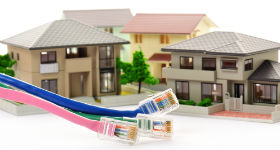How Fast Should Broadband Be? At Least 10 Mbps, Say Users
It's become downright axiomatic over the last few years that bandwidth consumers want two things: more bandwidth, and for that bandwidth to be delivered faster. In fact, a new study from Ovum suggests that, just to keep up with current expectations, Internet service providers (ISPs) need to increase minimum speed to 10 megabits per second (Mbps), a development that's actually good news for ISPs, in a certain sense.
The Ovum report looked at fixed-line consumer broadband, and totaled up all the various uses people wanted to see in broadband. Download speeds of at least 10Mpbs, stable networks that delivered content within three seconds of wait, and customer service that could resolve nearly every issue at the point of contact were all in on the action, and combined to make a pretty tall order for many ISPs to meet. Further, the research noted that one of the biggest drivers of bandwidth use these days is video, with both standard definition (SD) and high definition (HD) video contributing to the increasing use.
Michael Philpott, a practice leader in consumer services with Ovum and one of the reports' authors, noted that it wasn't just video driving demand, but the ever-increasing number of devices in the network that were driving gains in use. Homes in “mature markets,” Philpott noted, were apt to have as many as four devices connected to the network at the same time, offering up a wide array of potential applications. Philpott went on to elaborate, saying “Ever since broadband services were launched, there has been discussion on what is the definition of broadband and how much speed do consumers really need? In 2015, the answer is at least 10Mbps if you wish to receive a good-quality broadband experience, and a significant number of households, even in well-developed broadband countries, are well shy of this mark. With a clear link between poor user experience and customer churn, broadband service providers need to continue to invest in broadband infrastructure in order to provide their customers with the best broadband experience and maintain a satisfied customer base.”

I mentioned earlier that this was good news for ISPs, in a sense, because while it's a significant jump from what's currently being offered, it's actually not as big a jump as it could have been. Consumers want a 10Mbps connection in order to carry out the various tasks involved. The FCC, meanwhile, has pushed for an even bigger number just to have the service be considered broadband service in the first place; the FCC says it now takes a download speed of 25Mbps as of February 2015 to qualify. Basically, the consumers aren't going to fuss if just half of what the FCC wants is delivered. However, it does still mean that a lot more investment is necessary, particularly in those places where download speeds are still in the single digits, if such service is even available in the first place.
So clearly, broadband availability in the United States could use a shot in the arm. That's already happening in many places thanks to things like municipal fiber access and other developments, but there's still a long way to go from here.
Edited by Dominick Sorrentino

